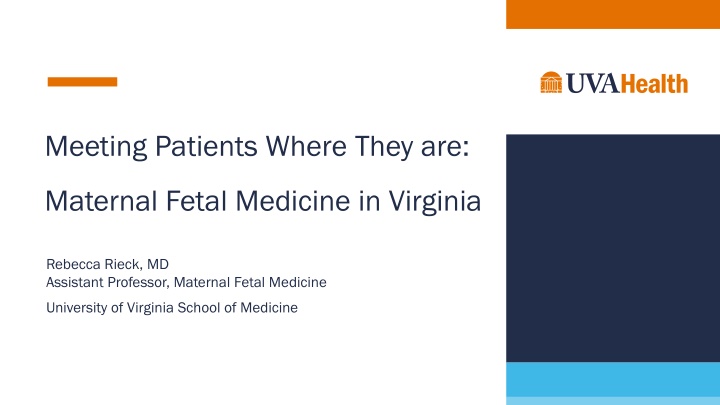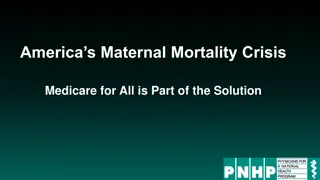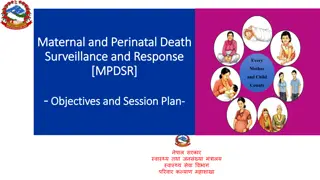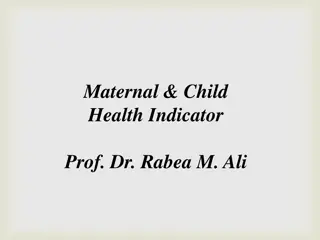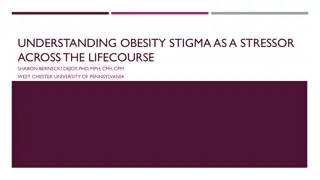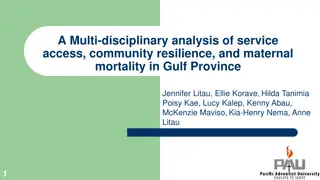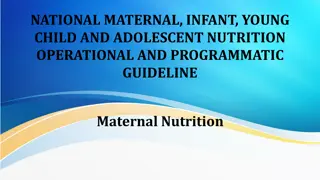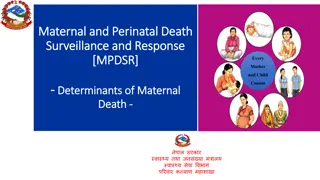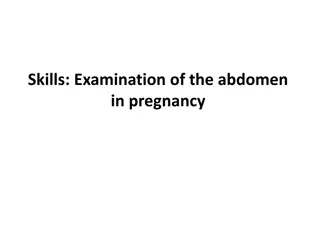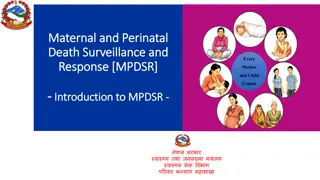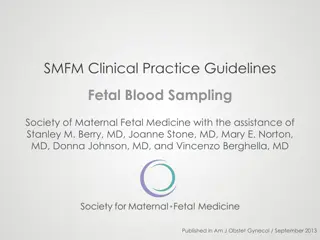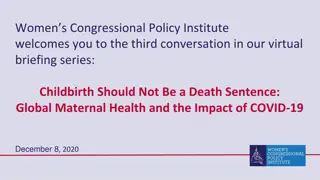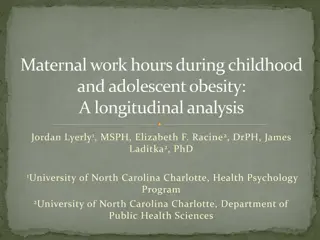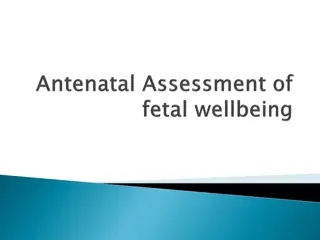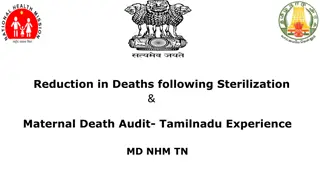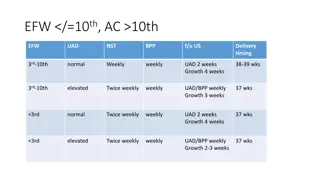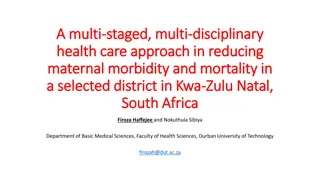Maternal Fetal Medicine in Virginia: Meeting Patients Where They Are
Maternal Fetal Medicine specialist Dr. Rebecca Rieck from University of Virginia School of Medicine focuses on managing hypertension in pregnancy. They offer remote patient monitoring for postpartum hypertension, achieving positive results and reducing hospital visits. The program covers diagnosis of various conditions like preeclampsia and chronic hypertension, with emphasis on patient follow-up and care.
Download Presentation

Please find below an Image/Link to download the presentation.
The content on the website is provided AS IS for your information and personal use only. It may not be sold, licensed, or shared on other websites without obtaining consent from the author.If you encounter any issues during the download, it is possible that the publisher has removed the file from their server.
You are allowed to download the files provided on this website for personal or commercial use, subject to the condition that they are used lawfully. All files are the property of their respective owners.
The content on the website is provided AS IS for your information and personal use only. It may not be sold, licensed, or shared on other websites without obtaining consent from the author.
E N D
Presentation Transcript
Meeting Patients Where They are: Maternal Fetal Medicine in Virginia Rebecca Rieck, MD Assistant Professor, Maternal Fetal Medicine University of Virginia School of Medicine
Hypertension in Pregnancy 15% of women have hypertension during pregnancy 80% of women have persistent hypertension after a pregnancy complicated by hypertensive diseases of pregnancy and 14% of women develop severe hypertension after hospital discharge Hypertension is a leading cause of maternal mortality, accounting for 6.3% of maternal deaths between 2017 and 2019 Only 58% of patients have postpartum follow-up Studies suggest that up to 39% of patients have persistent hypertension at 90 days
Remote Patient Monitoring for Postpartum Hypertension All patients with pregnancy complicated by hypertension Patients are enrolled in Locus Telehealth, our partner for remote patient monitoring, and provided with a blood pressure cuff upon hospital discharge Daily blood pressures are logged on the Locus Telehealth portal and reviewed by our nurse coordinator Patients have telemedicine visits with a provider within 72 hours of discharge then as needed based upon shared decision Remote Patient Monitoring typically lasts for 30 days after discharge
Results of Remote Patient Monitoring Diagnosis Preeclampsia Superimposed preeclampsia Chronic hypertension Gestational hypertension HELLP syndrome Eclampsia Comorbidities Obesity Chronic hypertension Fetal growth restriction Pregestational diabetes mellitus 134 (54.5) 71 (28.9) 15 (6.1) 13 (5.3) 8 (3.3) 2 (0.8) 246 patients enrolled between September 2019 and June 2023 Most patients on antihypertensive medication at discharge 50% remained on antihypertensive medication at program end Mean duration of RPM 32.94 days 123 (50) 86 (35) 46 (18.7) 35 (14.2) Gestational diabetes mellitus Multiple gestation Chronic kidney disease 26 (10.6) 13 (5.3) 2 (0.8) Data are presented as mean SD
Hospital Visits for Hypertension after Discharge Hospital Readmissions for Hypertension after Discharge
Broadband Access and Patient Care Solutions only work when patients can access them.
Opportunities for Expansion of High-Risk Obstetric Care in Virginia Postpartum Hypertension Remote Patient Monitoring Access to MFM consultation via telemedicine Development of expanded inpatient MFM consult services
References Fontenot, J, Lucas, R, Stoneburner, A, Brigance, C, Hubbard, K, Jones, E, Mishkin, K. Where You Live Matters: Maternity Care Deserts and the Crisis of Access and Equity in Virginia. March of Dimes. 2023. Fingar KR, Mabry-Hernandez I, Ngo-Metzger Q, Wolff T, Steiner CA, Elixhauser A. Delivery Hospitalizations Involving Preeclampsia and Eclampsia, 2005 2014: Statistical Brief #222. Healthcare Cost and Utilization Project (HCUP) Statistical Briefs. Published online 2006:1-26. Ford ND, Cox S, Ko JY, et al. Hypertensive Disorders in Pregnancy and Mortality at Delivery Hospitalization - United States, 2017-2019. MMWR Morb Mortal Wkly Rep. 2022;71(17):585-591. Centers for Disease Control and Prevention. Pregnancy Mortality Surveillance System. Accessed February 21, 2024. https://www.cdc.gov/reproductivehealth/maternal-mortality/pregnancy-mortality-surveillance-system.htm#causes Hitti J, Sienas L, Walker S, Benedetti TJ, Easterling T. Contribution of hypertension to severe maternal morbidity. Am J Obstet Gynecol. Published online 2018. doi:10.1016/j.ajog.2018.07.002 Podymow T, August P. Postpartum course of gestational hypertension and preeclampsia. Hypertens Pregnancy. 2010;29(3):294-300. Berks D, Steegers EAP, Molas M, Visser W. Resolution of hypertension and proteinuria after preeclampsia. Obstet Gynecol. 2009;114(6):1307- 1314. Malek AM, Wilson DA, Turan TN, Mateus J, Lackland DT, Hunt KJ. Maternal Coronary Heart Disease, Stroke, and Mortality Within 1, 3, and 5 Years of Delivery Among Women With Hypertensive Disorders of Pregnancy and Pre-Pregnancy Hypertension. J Am Heart Assoc. 2021;10(5):e018155. Hirshberg A, Downes K, Srinivas S. Comparing standard office-based follow-up with text-based remote monitoring in the management of postpartum hypertension: A randomised clinical trial. BMJ Qual Saf. 2018;27(11):871-877.
